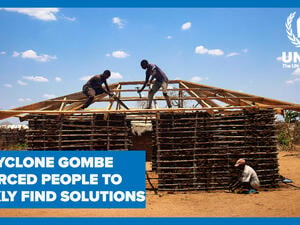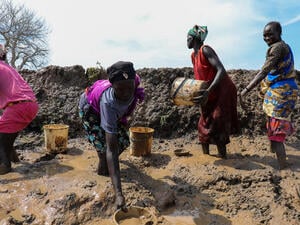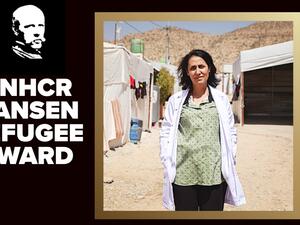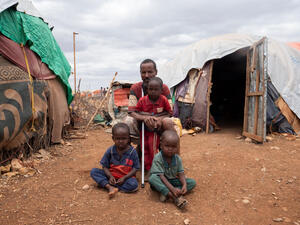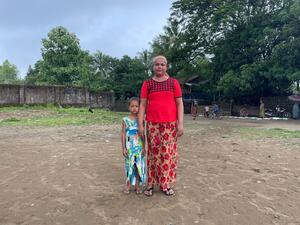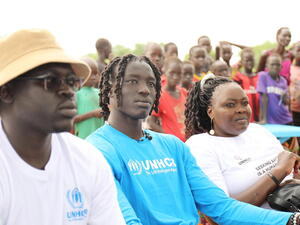Annual IDP report shows conflicts uproot millions; six-fold increase in Middle East
Annual IDP report shows conflicts uproot millions; six-fold increase in Middle East

A mother and child in Democratic Republic of the Congo. The mother has been displaced multiple times in the turbulent east of the country.
GENEVA, April 19 (UNHCR) - The Norwegian Refugee Council's (NRC) annual report on internal displacement said Thursday that there were 26.4 million people displaced within their own countries at the end of 2011, including 3.5 million forced to flee their homes during the year.
The study, prepared by NRC's Geneva-based Internal Displacement Monitoring Centre (IDMC), said some 830,000 of last year's newly displaced fled the impact of the Arab Spring uprisings, an almost six-fold increase from the 177,000 newly displaced in 2010.
"While the Arab Spring uprisings caused significant surges in internal displacement,"said Kate Halff, head of IDMC, "events in other regions, such as the spread of the armed conflict in Afghanistan and the activities of drug cartels and paramilitary gangs in Colombia, all added to this figure, while famine and conflict added to the already extreme vulnerabilities of millions of displaced people in Somalia."
The IDMC report, "The Global Overview 2011, People Displaced by Conflict and Violence," said that half-a-million people were internally displaced in Libya as a result of the conflict that led to the fall of Muammar Gaddafi's regime. By the end of the year, at least 154,000 people remained displaced, with many of those associated with Gaddafi's regime unable to return home as they faced reprisal attacks. Meanwhile, more than 156,000 people were newly displaced in Syria and at least 175,000 in Yemen.
In Somalia and Afghanistan, the long-drawn-out armed conflicts led to ever more internal displacement. In Afghanistan, the number of new displacements was 80 per cent higher than in the year before as the fighting spread to new regions. In Somalia, where 16 per cent of the total population live as IDPs (internally displaced people), those already displaced by the conflict were unable to resist the impact of the drought and famine which hit the Horn of Africa, and many starved to death.
In Côte d'Ivoire, up to a million people were internally displaced at the start of the year by fighting between supporters of the rival candidates in the presidential elections of late 2010. Both in Sudan and in the newly independent South Sudan, hundreds of thousands of people were internally displaced by the two countries' armed forces fighting rival militias.
The report said that many countries in which armed conflict had ended remained unstable and people continued to be forced to flee from criminal violence. In Colombia, the country with the largest number of IDPs in the world, criminal networks were the main drivers of displacement. Between 3.9 and 5.3 million Colombians were internally displaced at the end of 2011, and armed groups involved in drug trafficking were responsible for the highest number of large-scale new displacements.
In central Africa, the Lord's Resistance Army (LRA) continued to cause displacement by attacking civilians in the Democratic Republic of the Congo, South Sudan and the Central African Republic. An estimated 440,000 people are internally displaced or living as refugees owing to attacks by the rebel Ugandan group.
The good news in 2011 came from Africa. Here, the number of IDPs decreased from 11.1 million to 9.7 million, with significant returns taking place in Côte d'Ivoire, Chad and Uganda. With a total of 1.5 million African IDPs returned home by the end of 2011, this decrease in internal displacement follows a downward trend from 2004.
African governments have also shown real motivation to address internal displacement, by signing the African Union's Convention for the Protection and Assistance of Internally Displaced Persons in Africa. When it enters into force, the Kampala Convention will be the first legal instrument to bind governments across a continent to protect people from arbitrary displacement, provide protection and assistance to IDPs during displacement, and seek durable solutions for them.
In Iraq, levels of violence had fallen by the end of 2011 but well over 2 million people were trapped in protracted internal displacement. Their prospects were limited because the government was still unable to ensure a stable society with effective protection of all citizens.
"While the future remains uncertain for the escalating numbers of IDPs in Syria," said IDMC's Halff, "What the past has told us is that they, alongside the millions newly displaced across the world in 2011, face similar risks of protracted and even repeated displacement if governments, and their international partners, cannot ensure a stable environment for them."

